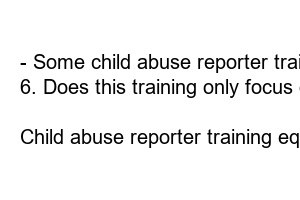아동학대 신고의무자 교육
Title: Child Abuse Reporter Training: Equipping Protectors with the Tools and Knowledge to Safeguard Our Children
Introduction:
Child abuse is a grave issue that affects countless lives across the globe. Identifying and reporting cases of abuse is crucial for the well-being and safety of children. To combat this daunting challenge, specialized training programs are essential. Child abuse reporter training equips individuals with the necessary skills, knowledge, and tools to effectively detect and report abuse cases. This transformative training prepares participants to become proactive protectors of children in our communities.
Subheading 1: What is child abuse reporter training?
Child abuse reporter training is a comprehensive program designed to educate individuals on recognizing signs of abuse, understanding the reporting process, and taking immediate action. Through practical workshops, seminars, and online resources, individuals learn how to confidently identify and report suspected cases of abuse.
Subheading 2: Understanding the importance of detecting child abuse
Detecting child abuse is crucial as victims often suffer silently, unable to speak up about their traumatic experiences. By undergoing child abuse reporter training, participants acquire the skills to identify subtle signs and behavioral changes, alerting them to potential abuse situations more effectively.
Subheading 3: Reporting procedures and obligations
Child abuse reporter training addresses the reporting procedures and legal obligations surrounding the reporting of abuse cases. Participants gain an in-depth understanding of their role, legal requirements, and how to handle sensitive information while respecting confidentiality.
Subheading 4: Recognizing different types of child abuse
Child abuse manifests in various forms, including emotional, physical, sexual, and neglectful abuse. This training program provides insights into recognizing the distinct signs and symptoms associated with each type of abuse, ensuring that no form of mistreatment goes unnoticed.
Subheading 5: Promoting a safe and supportive environment
Child abuse reporter training also focuses on creating a safe and supportive environment for children. Participants learn about preventive measures, such as establishing open communication channels, providing education on personal boundaries, and fostering trust, helping to prevent abuse before it occurs.
Subheading 6: The role of community involvement
Community involvement plays a vital role in combating child abuse. By attending this training, individuals learn how to collaborate with law enforcement, child protection agencies, and other community-based organizations to effectively respond to and prevent abuse cases.
Subheading 7: Frequently Asked Questions (FAQs):
1. Why is child abuse reporter training essential?
– Child abuse reporter training equips individuals to identify and report suspected cases of abuse, ensuring children receive the help and support they need.
2. Who can benefit from this training?
– Anyone who interacts with children, including teachers, healthcare professionals, social workers, and community members, can benefit from this training.
3. Is this training available online?
– Yes, many organizations offer online child abuse reporter training programs, providing accessibility and convenience for participants.
4. How long does the training usually last?
– The duration of the training can vary, but it typically ranges from a few hours to a few days, depending on the depth and scope of the program.
5. Are there any certifications awarded upon completion?
– Some child abuse reporter training programs offer certifications or professional accreditation to participants who successfully complete the training.
6. Does this training only focus on abuse detection, or does it address prevention as well?
– Child abuse reporter training encompasses both detection and prevention strategies, emphasizing the importance of creating safe environments for children.
Summary:
Child abuse reporter training equips individuals with the knowledge, skills, and resources necessary to detect, report, and prevent child abuse. Through understanding the signs of abuse, recognizing different types of mistreatment, and promoting a safe environment, participants become proactive protectors of children in their communities. This training is essential for anyone who interacts with children, promoting awareness, and fostering a strong network of support to safeguard the well-being of our most vulnerable.

